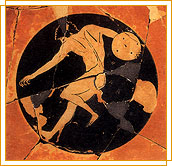The discus-thrower gear
Archaeological findings indicate that the discus was originally made of stone, and later of iron, lead but mostly of bronze.  The discus, consisted of two convex curves that had a large circumference and the same holds true today. It ranged from 17 to 32 cm in diameter, and weighed from 1.3 to 6.6 kilograms. However, larger discs have also been found that probably served as votive objects, like the one offered by Publius in Olympia, or that often had engraved decorations bearing athletic representations, like the "Berlin" discus. The discus, consisted of two convex curves that had a large circumference and the same holds true today. It ranged from 17 to 32 cm in diameter, and weighed from 1.3 to 6.6 kilograms. However, larger discs have also been found that probably served as votive objects, like the one offered by Publius in Olympia, or that often had engraved decorations bearing athletic representations, like the "Berlin" discus.
Pausanias mentioned that in order for the discus-throwers to compete under the same conditions, three equal-sized discuses were kept in the Sikyonian Treasure, in Olympia.
|
